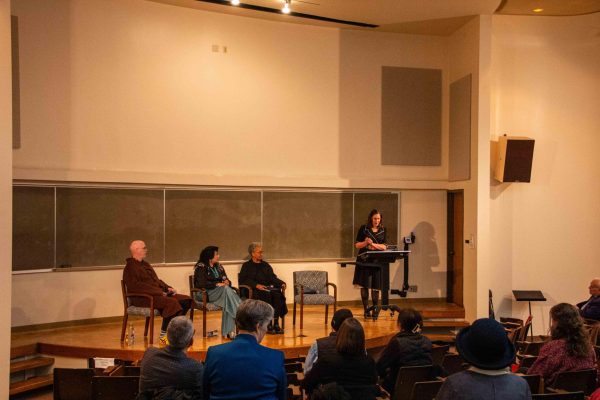
The Sheehan Gallery entices viewers in with bright pops of color and dynamic designs as it features a new artwork exhibition titled “FACT: fashion + art construct tomorrow.” Featuring artwork from Erik ReeL, Whitman ’73, and designs curated by Rhonda P. Hill, this exhibit emphasizes the ecological impacts of fashion. The gallery is decked out with interesting textures, saturated colors, 2D paintings and 3D mannequins. Dressed out in clothes designed from fabric waste, each mannequin has a unique feel with flowy skirts and dresses and creative silhouettes, complimenting the abstract geometric work of ReeL’s paintings.
Beyond curating FACT, Hill is the founder of Emerging Designers Get Exposed (EDGE), which is an online platform that analyzes fashion, its importance and how it can be used for advocacy.
“Fashion can be more than just what we wear, it’s an art form and it is a way that we can mark the sign of our times,” Hill said.
As part of the exhibition, the gallery team also organized a talk by Erik ReeL and a panel discussion with ReeL, Hill and designer Palani Bearghost to allow the community to get a glimpse of the thought behind these artworks. On Feb. 19, Erik ReeL held a talk titled “Where Are We?” In the talk, he delved into the thought process behind his work and the intersectionality of art and AI.
“It’s at this point, where for a lot of education institutions, colleges and universities, there’s a gap starting to appear between where they think they are and where the art world is and where the most advanced part of the art world is,” ReeL said.
These talks help bridge the gap between artists and viewers, and provided context for where and how ReeL’s art came about. Sophomore Denali Parodi, an English and Art History double major who attended the talk, emphasized how the discussion enriched her perspective of AI’s use in art.
“It was interesting to hear him talk about AI and improvisation, and how the area of free will and artists for artists is a place where AI can’t go,” Parodi said.
Attending the talk also allowed for the attendees to be able to view the art and the exhibition in a more holistic manner, helping create a deeper connection for viewers like Parodi.
“I see his art and I’m like woah, there’s so much to uncover, it’s something you want to look at for a long time and be immersed in,” said Parodi. “And seeing the descriptions talking about his inspirations and seeing how it’s from all over the place and channeled into his paintings is so cool.”
For Hill, the beauty of the gallery lies in the fact that there are so many ways to view art and that each visit opens up a new way to interact with the exhibit.
“There are so many levels that you can look at the exhibition with, there’s a technical, cultural, identity and environmental level. There are so many ways that you can absorb it, and it’s aesthetically beautiful too so there’s many ways to go in and look at it,” Hill said.
The gallery allows for the Whitman community to keep learning and interact with art and artists. By showing how waste can be reused and made aesthetically beautiful, the exhibit hopes to raise awareness about the harmful impact of waste and fast fashion, allowing viewers to connect and view the issues from a different perspective.
For ReeL, who has had his work displayed in numerous galleries throughout his career, the Sheehan Gallery is special because of its unique, tight-knit dynamic.
“It’s [Sheehan Gallery] actually one of the better spaces in the entire Pacific Northwest that shows live artists. There are other museums and other people, but they don’t allocate the same big space with small eyes,” ReeL said.
With the exhibition until April, interested attendees can swing by during the gallery’s open hours to learn more about fashion and art and how they create tomorrow.
